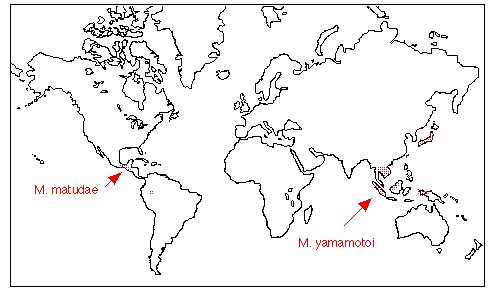 |
Mitrastemonaceae Makino
|
Distribution Map

Photographs
Mitrastemon matudae
- Photo. Chiapas, Mexico.
Photo by Dennis Breedlove.
- Photos.
Chiapas, Mexico. Link
goes to Flora of the World.
Mitrastemon yamamotoi
- Photo. Plants in full flower,
showing circumscissile dehiscence of the androecial tube. Near
Muroto-Shi, Kochi, Japan. Photograph by Michiyo Satou, published in
"World of Plants" article by Mitsuru Hirota (Weekly Asahihyakka, Jan.
22, 1995). Used with permission.
- Photo. Plants just past
flower. From the website of the Meeting of Miyakonojo valley plant
lovers, color photo album and flora (Japan).
- Photo. On roots of
Shikoku (Okinawa shii). Photo taken 15 November 1987. From "Praising
Flowers" website, Japan.
- Photo. Tokushima
prefecture Kaifu Gun. Photo taken 26 November 1989. From "Praising
Flowers" website, Japan.
- Drawing (from Makino 1911) by D.
Nickrent. Emerging bud (right) and open flowers (left and middle), both
in female phase.
- Photo. Habit of
plant at Lien-hua-Chih, Taiwan. Photo taken Nov. 11, 1995 by Shu-Chuan
Hsiao.
- Photos.
Series of photos of the flower. Taiwan. Photos by Mutolisp (Psilotum
Lin). Link goes to Flickr.
- Photos.
Series of photos of the flower. Taiwan. Photos by Mingiweng. Link
goes to Flickr.
- Photo.
Plants in flower. Nantou region, Taiwan. Photos by Leejoseph. Link
goes to Flickr.
- Photo. Close-up of plant at
Chitou, Taiwan. Photo taken Mar. 15, 1995 by Shu-Chuan Hsiao.
- Photos.
Malaysia. Link goes to
Flora of the World.
Names for the
Asian species. A number of names
of Mitrastemon have been (and are currently being) used to
refer to Asian material: M. cochinchinensis, M.
sumatranus, M. kanehirai, M.
kawasakii, and M. yamamotoi.
The latter three names, originally proposed by Yamamoto (1925,
1926), were later used by Watanabe in a large number of publications in
the 1930s (see references). Characters used to support the specific status
of these taxa involved the number of scale leaves (up to six pairs vs.
8-12 pairs), their shape (small, elongate elliptic vs. large, oblong), and
plant aspect (cylindrical vs. 4-angled, obconic). The most recent work to
examine the taxonomy of Mitrastemon was Meijer and Veldkamp
(1993) who concluded that because many intermediates among these "species"
exist, the variation represents local forms and ecotypes and that all
Asian specimens should be regarded as one variable species. Moreover, as
pointed out by van Royen (1963), all forms can be found in material from
Papua New Guinea. Hansen (1973) stated that it was not possible to
distinguish at the specific level the southeast Asian and Malesian
populations. Although technically challenging given the rarity of these
plants, a populational biosystematic study using molecular markers is
likely required to determine whether one or more species exist in Asia.
Until then, the conservative approach taken by Hansen (1973) and Meijer
and Veldkamp (1993) will be followed here.
Correct generic name. In
addition to Mitrastemon, there are
a couple of orthographic variants of the generic name, including Mitrastema
and Mitrastemma (I have not seen Mitrastemmon, but it's
likely out there too!). In fact, this web page had the genus as Mitrastema
for many years. A proposal to conserve the name Mitrastemon
was published by Reveal (Taxon 2010, 59: 299-300) and ruled on by the
Nomenclature Committee in 2011 (Brummitt 2011, Taxon 60 (4): 1206). Here's
what they said:
"In 1909 Makino published Mitrastemma
yamamotoi as a new genus and
species in a rather isolated English paragraph in an otherwise extensive
Japanese text. In his description on p. 327 he included "Stamens ...
mitriform ..." which was obviously the basis for his generic name.
However, stemma would refer to a
crown, while stamen should have been -stemon.
Mitra- is derived from the Latin
for a turban or other head-dress, which the fused stamens resemble. In
1911, on both pp. 253 and 255, Makino wrote "MITRASTEMON (sphalmate
MITRASTEMMA) Makino ..." "Sphalmate" means "in error", and he was clearly
stating that he was correcting the orthography of his own generic name.
This correction was accepted in the Code in 1966, when
Mitrastemonaceae was conserved with Mitrastemon
as the type genus - all in accordance with Makino's action. This has
been followed by the vast majority of authors since 1966, but the proposal
quotes a few dissenters who have perversely taken up Mitrastemma.
In a revision of the genus in 1993, Veldkamp & Meijer adopted a
different orthographic correction, using Mitrastema
with single m. They said simply that Makino "changed the name to Mitrastemon.
This change is not allowed, and Mitrastemon
is a superfluous name." But Art. 60.1 clearly allows correction of
orthographic (i.e., spelling) errors, and this must be the more so when
the correction is made by the author of the original spelling giving his
arguments. Some of the Committee have considered that it would make the
matter clearer if we accept the proposal, but that might set a bad
precedent. There is a principle involved (see also Prop. 1912 on Loxsoma
above). Mitrastemon is a
correction made by the original author himself and is already accepted in
the Code, and so must be adopted. A majority of the Committee considers
conservation unnecessary."
Correct family name. As
indicated above MitrastemonaceaeMakino (in Bot. Mag. Tokyo
25:252) was conserved as the family name in 1966 (ICBN App. IB). Alternate
(illegitimate) versions of the family name are also out there, such as
Mitrastemataceae, which is unfortunately used in the 2008 edition of the
Plant Book by Mabberley.
Phylogeny
This family, with but a single genus Mitrastemon, was shown to be
related to Ericales by Barkman et al. (2004) using mitochondrial matR
gene sequences. This result is confirmed using nuclear SSU rDNA and
mitochondrial sequence data (Nickrent
et
al. 2004).

Last updated:



